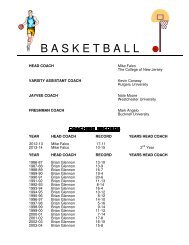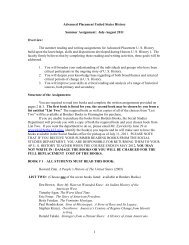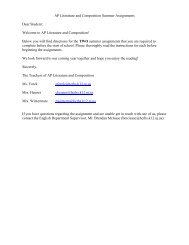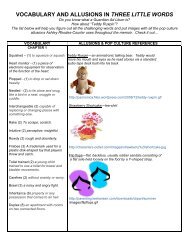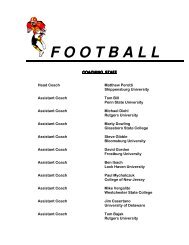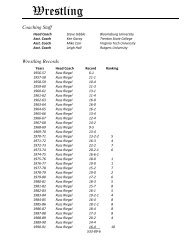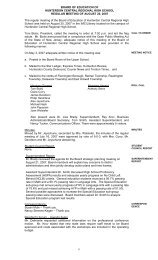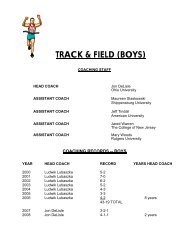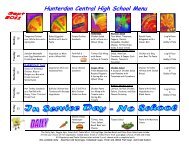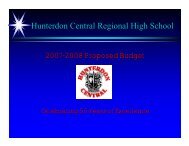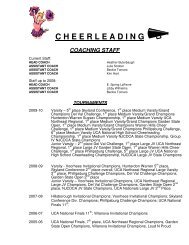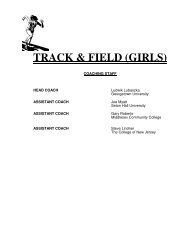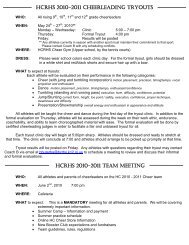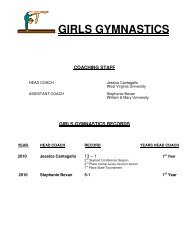Program of Studies - Hunterdon Central Regional High School
Program of Studies - Hunterdon Central Regional High School
Program of Studies - Hunterdon Central Regional High School
Create successful ePaper yourself
Turn your PDF publications into a flip-book with our unique Google optimized e-Paper software.
#804 - PRINCIPLES OF ENGINEERING - 5 CREDITS (DT 804 PRINC ENG)<br />
Grades: 11-12<br />
Prerequisite: #323 Geometry, #322 Geometry or #321 Honors Geometry<br />
Principles <strong>of</strong> Engineering is an advanced technology education course that engages students in various engineering<br />
applications including: mechanics, electronics, computer control, transportation, production, and robotics. Students apply<br />
a systematic approach to solve authentic engineering problems. Techniques utilized include Internet based research,<br />
computer aided design (CAD), and digital presentation. Modeling and prototyping are accomplished using hand tools,<br />
powered machines, and computer controlled equipment.<br />
#805 - TECHNOLOGY IN MATERIALS & PROCESS - 2.5 CREDITS (DT 805 MATERIALS TECH)<br />
Grades: 9-12<br />
Prerequisite: None<br />
In Materials and Processes students learn to use hand and machine tools while working with various materials including<br />
wood, metal, and plastic. Students learn to design, build, and finish numerous products. Students explore manufacturing<br />
and construction technologies. Emphasis is placed on design problem-solving and the proper use <strong>of</strong> tools.<br />
#807 - INTRODUCTION TO TECHNOLOGY - 2.5 CREDITS (DT 807 INTRO TO TECH)<br />
Grades: 9-12<br />
Prerequisite: None<br />
Introduction to Technology is designed to introduce students to technology education through hands-on problem-solving<br />
design challenges. Emphasis is placed on the nature, evolution, and the impact <strong>of</strong> technological systems.<br />
Communication, transportation, construction, manufacturing, and bio-related technologies are explored. Design activities<br />
involve graphic, mechanical and structural systems. This course is an excellent introduction to many <strong>of</strong> the other courses<br />
<strong>of</strong>fered by the Design Technology Department.<br />
#808 - INVENTION AND INNOVATIONS - 2.5 CREDITS (DT 808 INVENTIONS)<br />
Grades: 9-12<br />
Prerequisite: None<br />
Invention and Innovations introduces students to the techniques used by inventors and industrial designers to develop the<br />
products <strong>of</strong> the future. Students explore the nature <strong>of</strong> inventing, the social and economic consequences <strong>of</strong> invention, and<br />
the application <strong>of</strong> the design process to product innovation. Students identify, research, and develop solutions to realworld<br />
problems.<br />
#809 - MECHANICAL DRAWING - 2.5 CREDITS (DT 809 MECH DRAWING)<br />
Grades: 9-12<br />
Prerequisite: None. May not elect if student has previously taken #820 Drafting Technology, #810 Introduction<br />
to Engineering Design or #832 Architectural Design & Technology<br />
In Mechanical Drawing students learn drafting skills necessary for effective technical communication. The fundamentals<br />
<strong>of</strong> drafting are covered including sketching, traditional equipment use, line conventions, visualization, geometric<br />
construction, orthographic projection, dimensioning and isometric presentation. The student will also explore three<br />
dimensional modeling using a Computer Aided Design program. This course provides an effective foundation for the<br />
graphic representation <strong>of</strong> design solutions.<br />
#810 –INTRODUCTION TO ENGINEERING DESIGN- 5 CREDITS (DT #810 CAD)<br />
Grades: 10-12<br />
Prerequisite: None. May not elect if student has previously taken #820 Drafting Technology<br />
Introduction to Engineering Design is a semester course that is structured to provide students with computer skills related<br />
to the design experience. Students will use industry standard s<strong>of</strong>tware: AutoCAD and Inventor to solve design problems.<br />
Hands on prototyping, modeling and reverse engineering techniques will engage students with the process and methods<br />
<strong>of</strong> design. The students will complete projects in two and three dimensional design. The process requires students to<br />
analyze, research, sketch, choose a final designing solution and create finish products. Specific real life applications will<br />
include modeling, rendering, shading and shadowing all within industry standards required for engineering drawings.<br />
25



